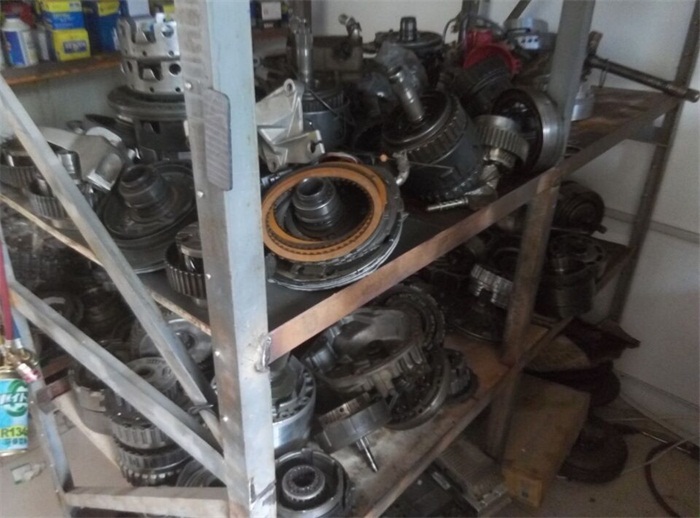


全國咨詢熱線
0531-82820798
苗經理(13806401238)
電話:0531-82820798
手機:13806401238
QQ:981562958
郵箱:981562958@qq.com
地址:濟南市槐蔭區張莊路8—3號
變速箱作為機械傳動的核心部件,長期運轉難免出現齒輪、軸承、軸類等零件的磨損,處理磨損問題需結合損傷程度與部件特性,通過精準檢測、分類修復與嚴格校驗,恢復其傳動精度與運行穩定性。
As the core component of mechanical transmission, the gearbox is inevitably subject to wear and tear on gears, bearings, shafts, and other parts during long-term operation. To deal with wear issues, it is necessary to combine the degree of damage and component characteristics, and restore its transmission accuracy and operational stability through precise detection, classification repair, and strict verification.
磨損檢測是修復的前提,需通過拆解與精密測量鎖定問題。將變速箱完全拆解后,先用專用清洗劑去除零件表面的油污、鐵屑,借助放大鏡觀察齒輪齒面是否有點蝕、剝落或階梯狀磨損,軸承滾道是否存在劃痕、凹陷,軸頸表面是否出現磨痕或橢圓度超差。使用千分尺、百分表等工具測量關鍵尺寸:齒輪的齒厚偏差若超過 0.15 毫米,可能導致嚙合間隙過大;軸承內圈與軸的配合間隙若超過 0.05 毫米,會引發運轉異響;軸類零件的直線度誤差若超過 0.03 毫米 / 米,需進行矯正。同時,檢查同步器錐環、換擋撥叉等易損件的磨損情況,如錐環內錐面的螺紋槽是否磨平,撥叉與槽的配合間隙是否超標,這些細節直接影響換擋平順性。
Wear detection is a prerequisite for repair, and locking issues need to be addressed through disassembly and precise measurement. After completely disassembling the gearbox, use a specialized cleaning agent to remove oil stains and iron filings from the surface of the parts. Use a magnifying glass to observe whether there is pitting, peeling, or stepped wear on the gear teeth, whether there are scratches or dents on the bearing raceway, and whether there are wear marks or ovality deviations on the journal surface. Use tools such as micrometers and dial indicators to measure key dimensions: if the tooth thickness deviation of the gear exceeds 0.15 millimeters, it may lead to excessive meshing clearance; If the clearance between the inner ring of the bearing and the shaft exceeds 0.05 millimeters, it will cause abnormal noise during operation; If the straightness error of shaft components exceeds 0.03 millimeters per meter, correction is required. At the same time, check the wear of vulnerable parts such as the synchronizer cone ring and shift fork, such as whether the threaded groove on the inner cone surface of the cone ring is worn flat, and whether the clearance between the shift fork and the groove exceeds the standard. These details directly affect the smoothness of shifting.
針對不同磨損程度,修復方式需分級處理。輕度磨損(如齒輪齒面僅有輕微劃痕、軸頸表面光潔度下降)可采用研磨拋光技術:用細砂紙或研磨膏手工打磨,配合專用研磨工具保持零件原有的幾何形狀,避免過度磨削導致尺寸精度喪失。例如,對軸承座孔的輕微磨損,可用珩磨工具進行內孔研磨,恢復其圓度與表面粗糙度,確保軸承裝配后運轉平穩。中度磨損(如齒輪嚙合間隙超標但齒根未受損、軸頸出現均勻磨損)可采用電刷鍍或激光熔覆技術:電刷鍍通過電解作用在磨損表面沉積一層金屬鍍層(如鎳基合金),厚度控制在 0.05-0.2 毫米,經打磨后恢復配合尺寸;激光熔覆則利用高能激光將合金粉末熔覆在磨損部位,形成與基體結合牢固的耐磨層,適用于承受較大載荷的齒輪、軸類零件,熔覆后需通過數控加工保證精度。
For different degrees of wear, the repair methods need to be graded. Mild wear (such as only slight scratches on the gear tooth surface or a decrease in the surface smoothness of the shaft neck) can be treated with grinding and polishing techniques: manually polish with fine sandpaper or grinding paste, and use specialized grinding tools to maintain the original geometric shape of the part, avoiding excessive grinding and loss of dimensional accuracy. For example, for slight wear of the bearing seat hole, honing tools can be used to grind the inner hole, restore its roundness and surface roughness, and ensure smooth operation of the bearing after assembly. Moderate wear (such as gear mesh clearance exceeding the standard but without damage to the tooth root, and uniform wear on the shaft neck) can be treated with electric brush plating or laser cladding technology: electric brush plating deposits a layer of metal coating (such as nickel based alloy) on the worn surface through electrolysis, with a thickness controlled at 0.05-0.2 millimeters, and after polishing, the fit size is restored; Laser cladding uses high-energy lasers to fuse alloy powder onto the worn area, forming a wear-resistant layer that is firmly bonded to the substrate. It is suitable for gear and shaft parts that can withstand large loads, and the precision needs to be ensured through CNC machining after cladding.

嚴重磨損或結構損傷的零件需果斷更換,避免修復后留下隱患。當齒輪出現斷齒、齒面剝落面積超過 20%,軸承滾道裂紋或保持架損壞,軸類零件出現彎曲變形或裂紋時,必須更換新件,且新件需與原規格一致(包括材料牌號、熱處理硬度等),如齒輪常用 20CrMnTi 滲碳淬火(表面硬度 58-62HRC),軸類多用 45 鋼調質處理(硬度 220-250HB)。更換同步器、離合器片等易損件時,需同時檢查相關配合部件,如同步器鎖環與齒輪錐面的接觸面積需達到 70% 以上,確保換擋時能迅速同步。裝配新件前,需進行清洗與預潤滑,避免雜質混入或干摩擦導致二次磨損。
Parts with severe wear or structural damage should be replaced promptly to avoid potential hazards after repair. When gears have broken teeth, tooth surface peeling area exceeds 20%, bearing raceway cracks or retaining frame damage, and shaft parts have bending deformation or cracks, new parts must be replaced, and the new parts must be consistent with the original specifications (including material grade, heat treatment hardness, etc.). For example, gears are commonly treated with 20CrMnTi carburizing and quenching (surface hardness 58-62HRC), and shafts are often treated with 45 steel quenching and tempering (hardness 220-250HB). When replacing vulnerable parts such as synchronizers and clutch plates, it is necessary to check the relevant mating components at the same time. For example, the contact area between the synchronizer lock ring and the gear cone surface should reach more than 70% to ensure rapid synchronization during gear shifting. Before assembling new parts, cleaning and pre lubrication are necessary to avoid impurities or dry friction that may cause secondary wear.
修復后的裝配與校驗是保障性能的關鍵。按照拆解相反順序裝配,所有零件需涂抹專用變速箱油(按車型要求選擇礦物油或合成油),軸承、齒輪的安裝需使用專用工具(如壓套、拉馬),避免蠻力敲擊導致零件變形。裝配過程中,需多次測量嚙合間隙(齒輪副側隙通常為 0.1-0.3 毫米)、軸向竄動量(軸類零件一般不超過 0.15 毫米),通過調整墊片厚度確保參數達標。完成裝配后,進行臺架試驗:模擬不同轉速與載荷,測試變速箱的換擋靈活性、運轉噪音(空載時噪音應≤75 分貝)、油溫變化(連續運轉 1 小時后油溫不超過 80℃),若發現異常響動或換擋卡滯,需拆解檢查并重新調整。
The assembly and verification after repair are key to ensuring performance. Assemble in the reverse order of disassembly, and all parts need to be coated with specialized transmission oil (choose mineral oil or synthetic oil according to the requirements of the vehicle model). The installation of bearings and gears requires the use of specialized tools (such as press fit and pull tab) to avoid deformation of parts caused by brute force impact. During the assembly process, it is necessary to measure the meshing clearance (usually 0.1-0.3 millimeters for gear pairs) and axial displacement (generally not exceeding 0.15 millimeters for shaft parts) multiple times, and ensure that the parameters meet the standards by adjusting the thickness of the gasket. After assembly, conduct bench tests: simulate different speeds and loads to test the shifting flexibility, operating noise (noise should be ≤ 75 decibels when unloaded), and oil temperature changes (oil temperature should not exceed 80 ℃ after continuous operation for 1 hour) of the gearbox. If abnormal noise or shifting jamming is found, it needs to be disassembled, inspected, and readjusted.
本文由濟南自動變速箱維修友情奉獻.更多有關的知識請點擊:http://www.09au.com真誠的態度.為您提供為全面的服務.更多有關的知識我們將會陸續向大家奉獻.敬請期待.
This article is a friendly contribution from Jinan Automatic Transmission Maintenance For more information, please click: http://www.09au.com Sincere attitude To provide you with comprehensive services We will gradually contribute more relevant knowledge to everyone Coming soon.